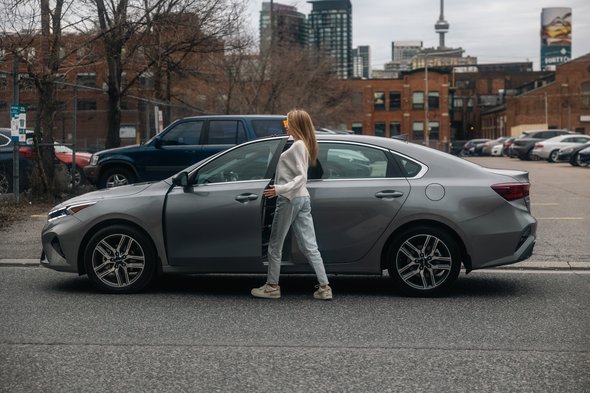
LEASING
How Does Leasing a Car Work? An In-Depth Overview
What you’ll be learning about in our car leasing overview:
- What leasing is and how it works
- Benefits of leasing compared to buying a car
- Options at the end of a lease
- Pros and cons of leasing a vehicle
Last Updated September 25, 2023
5 min read
So, you’re considering getting a new set of wheels, but you're unsure about the traditional route of buying? You may have come across the option of leasing a car and wondered, “How exactly does that work?” We've got you covered! At Roam, we specialize in vehicle subscriptions, but we understand the broader landscape of automotive options. Here's a thorough breakdown of how to lease a car, along with the benefits and things you should be aware of.
What Is Car Leasing, Anyway?
Car leasing is a lot like renting. When you lease a car, you’re essentially renting it from a leasing company for a set number of years. Unlike our month-to-month subscriptions at Roam, leasing often binds you to longer terms, typically ranging from 2 to 4-year leases. At the end of the lease term, you have the option to buy the car, extend the lease, or simply return it and walk away.
The Mechanics Behind Leasing a Car
To truly understand how leases work, we need to delve into the financial aspect of it:
Upfront Costs & Monthly Lease Payments
Just like when you buy a car and have to make a down payment, when you lease a car, there's usually an upfront cost. This can vary based on your leasing options, but typically, the higher your initial payment, the lower your monthly lease payments will be. These monthly payments cover the depreciation of the car during the lease term and any associated interest charges.
Residual Value: What's That?
One of the key terms to know when delving into the world of car leasing is 'residual value'. This is the estimated worth of the car at the end of the lease term. Your monthly lease payments, in essence, cover the difference between the car’s initial price and its residual value. For instance, if you lease a car valued at $30,000, and its residual value after three years is expected to be $15,000, your payments would cover that $15,000 difference.
Benefits of Leasing Over Buying
Leasing a vehicle certainly comes with its own set of advantages:
Lower Monthly Payments
When you opt for an auto loan to buy a car, you're financing the entire cost of the vehicle. In contrast, with leasing, you're only paying for the depreciation that occurs during your lease term. This often means that monthly lease payments can be lower than loan payments, making it a tempting option for many.
Frequent Upgrades
One of the undeniable benefits of leasing is the flexibility to change cars every few years. Tired of your current model? No problem. Once your lease term ends, you can simply return it and choose a newer model. This means you can always be driving a car with the latest tech and features.
Less Long-Term Commitment
If you're someone who doesn’t want to commit to a car for the long term, leasing is an ideal solution. Whether your lifestyle is dynamic or you like frequent changes, leasing provides a solution without the ties of full ownership.
Points to Consider Before Leasing
Kilometre Limit
Leasing agreements often come with a kilometre limit. If you're someone who drives a lot, this is something to be wary of. Exceeding this limit can result in charges for every additional kilometre. It's essential to estimate your driving habits before signing on that dotted line.
Excessive Wear and Tear
Leasing companies expect their vehicles to be returned in relatively good condition. While normal wear and tear are understandable, excessive dings, scratches, or interior damage can result in additional fees.
Delving Deeper into Car Leasing
As we navigate the intricacies of car leasing, let's delve into some of the lesser-known aspects to give you a comprehensive understanding:
Gap Insurance: A Safety Net
When you lease a car, it's essential to understand the role of gap insurance. If your leased vehicle gets stolen or totalled in an accident, your insurance might only cover the car's current market value, which could be less than what you owe on your lease. Gap insurance bridges this "gap", ensuring that you're not out of pocket for the difference. While some leasing companies might include it in the contract, others might not, so always inquire and consider adding it if it's not already there.
The End-of-Lease Options
As the end of your lease term approaches, you'll be faced with a few choices:
- Buy the Car: If you've grown attached to the vehicle, you can choose to buy it. The price is often the residual value set at the beginning of the lease.
- Return and Walk Away: After ensuring there's no excessive wear and tear and you haven’t exceeded the kilometre limit, you can hand back the keys and move on.
Lease a New Car: Loved the experience? You can always initiate a new lease and drive away with a brand-new model.
Lease vs. Auto Loan: A Quick Comparison
Leasing:
- Lower monthly payments since you're only paying for depreciation.
- Flexibility to switch cars after the lease term.
- Potential for excessive wear and tear charges and kilometre overage fees.
Car Loan:
- You own the vehicle once the loan is paid off.
- No kilometre restrictions or wear and tear fees.
- Loan payments might be higher, but you build equity in the vehicle.
Navigating the Pros and Cons of Leasing
The Upside of Leasing
- Financial Flexibility: With potentially lower monthly payments, you might free up some budget for other priorities or desires.
- Staying Current: With the ability to switch cars frequently, you can enjoy the latest models and technological advancements.
- Warranty Coverage: Many leases last around the same duration as the manufacturer's warranty, ensuring you're mostly covered for repairs.
The Downside of Leasing
- Lack of Ownership: At the end of the lease term, you don’t own the car (unless you choose to buy it).
- Potential for Additional Costs: From kilometer overages to excessive wear and tear charges, there could be extra fees if you're not careful.
- Commitment: Even if your needs change, breaking a lease can be expensive and challenging.
Final Thoughts
Leasing a vehicle can be an excellent option for many, especially those looking for lower monthly commitments and the thrill of regularly upgrading to newer models. However, like all financial decisions, it's imperative to read the fine print, understand the terms, and determine if it aligns with your long-term goals and lifestyle.
Whether you choose to lease a car or dive into the world of car subscriptions with Roam, understanding your options with our always-free education and content will ensure you make the best choice for your unique needs. Safe travels and happy driving!
Try a Roam Car Subscription today
Book your first car subscription in minutes and leave the burdens of traditional car ownership behind.
